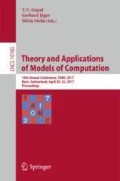Abstract
In this work we present a short and unified proof for the Strong and Weak Regularity Lemma, based on the cryptographic technique called low-complexity approximations. In short, both problems reduce to a task of finding constructively an approximation for a certain target function under a class of distinguishers (test functions), where distinguishers are combinations of simple rectangle-indicators. In our case these approximations can be learned by a simple iterative procedure, which yields a unified and simple proof, achieving for any graph with density d and any approximation parameter \(\epsilon \) the partition size
-
a tower of 2’s of height \(O\left( d_{}\epsilon ^{-2} \right) \) for a variant of Strong Regularity
-
a power of 2 with exponent \(O\left( d\epsilon ^{-2} \right) \) for Weak Regularity
The novelty in our proof is: (a) a simple approach which yields both strong and weaker variant, and (b) improvements when \(d=o(1)\). At an abstract level, our proof can be seen a refinement and simplification of the “analytic” proof given by Lovasz and Szegedy.
This paper (with updates) is available on https://eprint.iacr.org/2016/965.pdf
M. Skórski—Supported by the European Research Council Consolidator Grant (682815-TOCNe).
Access this chapter
Tax calculation will be finalised at checkout
Purchases are for personal use only
Notes
- 1.
The requirement of being “sufficiently big” is to make this notion equivalent with the irregularity above.
- 2.
Worse bounds were known before for example [Gow97].
- 3.
The original work [LS07] proves a bound being \(O(\epsilon ^{-2})\) iterations of the function \(s(1)=1\), \(s(k+1)=2^{s(1)^4\ldots s(k)^4}\) starting at 1. It is easy to see that s(k) can be bounded by a tower of height \(k+O(1)\).
- 4.
The generated partition arises as intersections of the generating sets with their complements.
- 5.
If we consider the mapping \(h\rightarrow \max _{f} \left| \underset{e\leftarrow {\mathcal {X}}}{{{\mathrm{{\mathbb {E}}}}}} g(e)f(e) - \underset{e\leftarrow {\mathcal {X}}}{{{\mathrm{{\mathbb {E}}}}}} h(e)f(e)\right| \) then its subgradient equals f for some \(f\in {\mathcal {F}}\). Then the update is \(h:= h-t\cdot f\) precisely as in the proof of Sect. 2.1.
- 6.
The relaxed form we use is except that we allow any numbers \(d_{i,j}\) in place of densities \(d_G(V_i,V_j)\).
- 7.
This property was also implicitly used in [LS07].
References
Duke, R.A., Lefmann, H., Rdl, V.: A fast approximation algorithm for computing the frequencies of subgraphs in a given graph. SIAM J. Comput. 24(3), 598–620 (1995)
Frieze, A., Kannan, R.: A simple algorithm for constructing szemeredi’s regularity partition. Electron. J. Comb. [electronic only] 6(1), Research paper R17, 7 p. (eng) (1999)
Frieze, A.M., Kannan, R.: Quick approximation to matrices and applications. Combinatorica 19(2), 175–220 (1999)
Fox, J., Lovász, L.M.: A tight lower bound for szemerédi’s regularity lemma. CoRR abs/1403.1768 (2014)
Gowers, W.T.: Lower bounds of tower type for szemerédi’s uniformity lemma. Geom. Funct. Anal. GAFA 7(2), 322–337 (1997)
Hajnal, A., Maass, W., Turán, G.: On the communication complexity of graph properties. In: Proceedings of the Twentieth Annual ACM Symposium on Theory of Computing, STOC 1988, New York, pp. 186–191. ACM (1988)
Jetchev, D., Pietrzak, K.: How to fake auxiliary input. In: Lindell, Y. (ed.) TCC 2014. LNCS, vol. 8349, pp. 566–590. Springer, Heidelberg (2014). doi:10.1007/978-3-642-54242-8_24
Kohayakawa, Y., Rdl, V.: Szemeredi’s regularity lemma and quasi-randomness (2002)
Komls, J., Simonovits, M.: Szemeredi’s regularity lemma and its applications in graph theory (1996)
Lovász, L., Szegedy, B.: Szemerédi’s lemma for the analyst. Geom. Funct. Anal. 17(1), 252–270 (2007). MR MR2306658 (2008a:05129)
Rdl, V., Schacht, M.: Regularity lemmas for graphs
Szemeredi, E.: On sets of integers containing no k elements in arithmetic progression (1975)
Trevisan, L., Tulsiani, M., Vadhan, S.: Regularity, boosting, and efficiently simulating every high-entropy distribution. In: Proceedings of the 24th Annual IEEE Conference on Computational Complexity, CCC 2009, Washington, DC, USA, pp. 126–136. IEEE Computer Society (2009)
Vadhan, S., Zheng, C.J.: A uniform min-max theorem with applications in cryptography. In: Canetti, R., Garay, J.A. (eds.) CRYPTO 2013. LNCS, vol. 8042, pp. 93–110. Springer, Heidelberg (2013). doi:10.1007/978-3-642-40041-4_6
Author information
Authors and Affiliations
Corresponding author
Editor information
Editors and Affiliations
A Proof of Lemma 2
A Proof of Lemma 2
Proof
Let d be the edge density of the pair (T, S) and \(d'\) be the edge density of the pair \((T',S')\). Denote \(\epsilon = \mathrm {irreg}_{G}(T,S)\). For any two subsets \(T'' \subset T', S''\subset S'\), which are also subsets of T and S respectively, by the definition of d we have
which translates to
Therefore, by Eq. (19) and the triangle inequality
Since the definition of d applied to \(T''\subset T, S''\subset S\) implies
from Eq. (20) we conclude that
which finishes the proof.
Rights and permissions
Copyright information
© 2017 Springer International Publishing AG
About this paper
Cite this paper
Skórski, M. (2017). A Cryptographic View of Regularity Lemmas: Simpler Unified Proofs and Refined Bounds. In: Gopal, T., Jäger , G., Steila, S. (eds) Theory and Applications of Models of Computation. TAMC 2017. Lecture Notes in Computer Science(), vol 10185. Springer, Cham. https://doi.org/10.1007/978-3-319-55911-7_42
Download citation
DOI: https://doi.org/10.1007/978-3-319-55911-7_42
Published:
Publisher Name: Springer, Cham
Print ISBN: 978-3-319-55910-0
Online ISBN: 978-3-319-55911-7
eBook Packages: Computer ScienceComputer Science (R0)

